|
|
|
Sort Order |
|
|
|
Items / Page
|
|
|
|
|
|
|
| Srl | Item |
| 1 |
ID:
183021


|
|
|
|
|
| Summary/Abstract |
How does combat affect insurgent violence against civilians? Existing studies emphasize the role of combat outcomes, but have not explored the direct effects of various combat events. This article argues that one such event, government attacks on the rebels, has a positive effect on insurgent violence that stems from the logic of guerrilla warfare. In guerrilla wars, government forces tend to rely on informants in finding the insurgents. Their attacks therefore often evince civilian denunciation. To deter future denunciations, the rebels have incentives to subsequently punish the suspected or known denunciator. This argument is probed using detailed original data from Nepal’s Maoist insurgency. A panel analysis shows that government attacks were positively associated with rebel violence against civilians, and especially with violence against suspected informants. Process-tracing evidence further supports the argument, suggesting that the rebels used violence strategically to prevent information leaks and government attacks.
|
|
|
|
|
|
|
|
|
|
|
|
|
|
|
|
| 2 |
ID:
108842
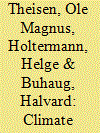

|
|
|
|
|
| Publication |
2011-12.
|
| Summary/Abstract |
Dominant climate models suggest that large parts of Africa will experience greater climatic variability and increasing rates of drought in coming decades. This could have severe societal consequences, because the economies and food supplies of most African countries depend on rain-fed agriculture. According to leading environmental security scholars, policymakers, and nongovernmental organizations, an increase in scarcity-driven armed conflicts should also be expected. A conditional theory of environmental conflict predicts that drought increases the risk of civil war primarily when it strikes vulnerable and politically marginalized populations in agrarian societies. However, an empirical evaluation of this general proposition through a unique gridded dataset of postcolonial Africa, which combines high-resolution meteorological data with georeferenced data on civil war onset and the local ethnopolitical context, shows little evidence of a drought-conflict connection. Instead, the local risk of civil war can be explained by sociopolitical and geographic factors: a politically marginalized population, high infant mortality, proximity to international borders, and high local population density.
|
|
|
|
|
|
|
|
|
|
|
|
|
|
|
|
| 3 |
ID:
167424
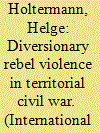

|
|
|
|
|
| Summary/Abstract |
Much of the violence carried out by rebels seeking secession or territorial autonomy occurs within the area under dispute. Still, territory-seeking rebels sometimes attack civilians in other parts of the country. By developing a diversionary theory of violence, this article helps explain why and when they do so. Rebels in territorial disputes aim to keep the government's forces out of their claimed homeland. Attacking civilians outside of the disputed area may help achieve this aim because it pushes the government to disperse its forces and commit resources to protection. Incentives for such diversionary violence are likely to prove particularly high during military offensives, when the government seeks to concentrate its forces in the contested area. I first assess the theory through a quantitative analysis of territorial conflicts worldwide between 1989 and 2015. Second, I conduct a case study of the Sri Lankan Eelam Wars, combining process-tracing and a quantitative test using new events data. I find that rebels do tend to escalate violence outside their claimed territory during government offensives and that diversion is an important causal mechanism.
|
|
|
|
|
|
|
|
|
|
|
|
|
|
|
|
| 4 |
ID:
144924
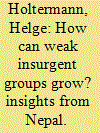

|
|
|
|
|
| Summary/Abstract |
How can insurgent groups that are militarily far weaker than the state survive and grow? Influential accounts drawing on Kalyvas' “control-collaboration” model argue that limited state reach can make this possible by allowing rebel groups to carve out pockets of control where they can elicit collaboration. I suggest that this account is inadequate. Even states with limited reach are likely to transfer sufficient forces to rebel-affected areas to establish at least partial control. Weak rebels therefore often face the challenge of building capacity without local control to begin with. I identify two broad factors that can make this feasible: first, strong pre-existing rebel networks, which facilitate collaboration through solidarity, norms of reciprocity, and social incentives; and second, counterinsurgency policies and practices that fail to exploit the opportunities that control offers for incentivizing collaboration and shaping political preferences. These arguments are grounded in a fieldwork-based case study of insurgency processes in a hamlet of Rolpa, Nepal.
|
|
|
|
|
|
|
|
|
|
|
|
|
|
|
|
| 5 |
ID:
107971
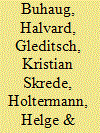

|
|
|
|
|
| Publication |
2011.
|
| Summary/Abstract |
Income varies considerably within countries and the locations where conflicts emerge are rarely typical or representative for states at large. Yet, most research on conflict has only examined national income averages and neglected spatial variation. The authors argue that civil conflicts are more likely to erupt in areas with low absolute income, even if a country's gross domestic product (GDP) per capita is not necessarily low, and in areas with large deviations from national averages. The authors test these hypotheses empirically using spatially disaggregated data on the location of conflict outbreaks and per capita income estimates. The authors find that areas with absolute poverty indeed see more outbreaks of conflict, and they find some evidence that inequality increases the risk of conflict. Subnational information can improve on conventional country-based measures and help our understanding of how local features and variation can give rise to mobilization and violence.
|
|
|
|
|
|
|
|
|
|
|
|
|
|
|
|
| 6 |
ID:
144801
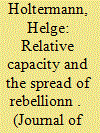

|
|
|
|
|
| Summary/Abstract |
This article explores how insurgencies emerge and spread within a country over time through an analysis of the Maoist insurgency in Nepal. It argues that important processes underpinning the spread of insurgency are likely to change with shifts in the relative military capacity of belligerents. Importantly, insurgents can to a greater extent spread the insurgency by using coercion, material incentives, and movement of forces when they are militarily strong than when they are weak. This in turn leads to changes in the local conditions favorable to insurgency. I hypothesize that inaccessible terrains, preexisting rebel networks, and proximity to insurgent areas are likely to be important determinants of local insurgency onset during rebel weakness, but should decline in importance as the rebels gain strength. I find support for these arguments in a mixed-methods analysis of Nepal’s insurgency that combines a qualitative narrative and a quantitative event history analysis.
|
|
|
|
|
|
|
|
|
|
|
|
|
|
|
|
|
|
|
|
|